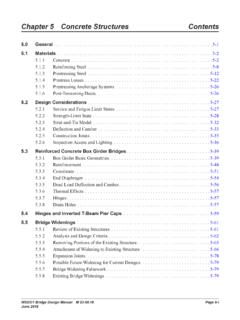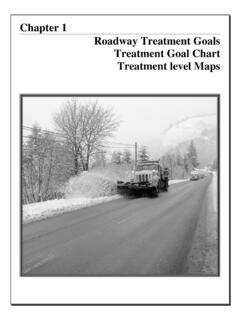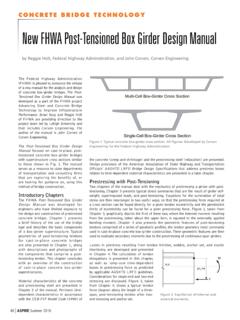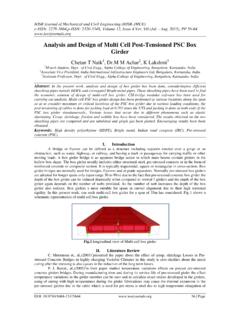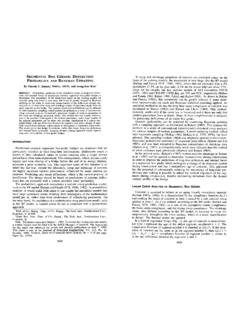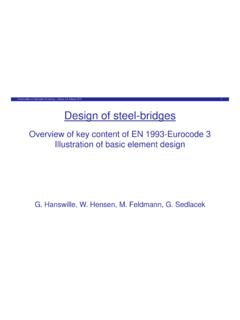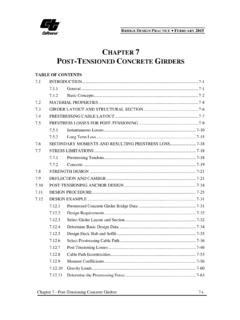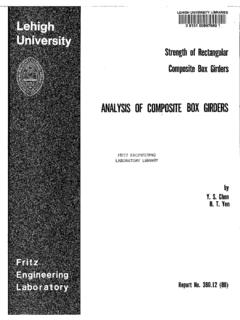Transcription of Chapter 6 Structural Steel Contents
1 WSDOT bridge design Manual M Page 6-i July 2019 Chapter 6 Structural Steel Structural Steel .. Introduction .. Special Requirements for Steel bridge Rehabilitation or Modification .. Retrofit of Low Vertical Clearance Truss Portal and Sway Members .. design Considerations .. Codes, Specification, and Standards .. WSDOT Steel bridge Practice .. Preliminary Girder Proportioning .. Estimating Structural Steel Weights .. bridge Steels .. Plate Sizes .. Girder Segment Sizes .. Computer Programs .. Fasteners .. Bending Steel .. Girder Bridges .. design of I- girders .. Limit States for AASHTO LRFD .. Composite Section .. Flanges .. Webs .. Transverse Stiffeners .. Longitudinal Stiffeners .. Bearing Stiffeners.
2 Cross Frames .. Bottom Laterals .. Bolted Field Splice for girders .. Camber .. bridge Deck Placement Sequence .. bridge Bearings for Steel girders .. Surface Roughness and Hardness .. Welding .. Shop Assembly ..6-29 Chapter 6 Structural SteelPage 6-ii WSDOT bridge design Manual M July Plan Details .. General .. Structural Steel Notes .. Framing Plan .. Girder Elevation .. Typical Girder Details .. Cross Frame Details .. Camber Diagram and Bearing Stiffener Rotation .. bridge Deck .. Handrail Details, Inspection Lighting, and Access .. Box Girder Details .. Shop Plan Review .. Painting of Existing Steel Bridges .. General .. Vertical Analysis .. Horizontal Analysis .. Special Considerations.
3 Quantities and Estimates .. bridge Standard Drawings ..6-43 Structural Steel .. References ..6-44 WSDOT bridge design Manual M Page 6-1 July 2019 Chapter 6 Structural Structural IntroductionThis Chapter primarily covers design and construction of Steel plate and box girder bridge superstructures. Because of their limited application, other types of Steel superstructures (truss, arch, cable stayed, suspension, etc.) are not addressed except as it relates to retrofit of truss sway and portal frames and for painting of existing Steel girder bridges are commonly used for river crossings and curved interchange ramps. Typical span lengths range from 150 to 300 feet. Steel girders are also being used where limited vertical clearance requires shallow superstructure depth.
4 They may be set over busy highway lanes with a minimum of disruption and falsework, similar to precast concrete elements. Longitudinal launching of Steel framing and transverse rolling of completed Steel structures has been done units are the current standard for detailing. Widening or rehabilitation plan units should be consistent with the Special Requirements for Steel bridge Rehabilitation or ModificationAs part of Steel bridge rehabilitation or modification, calculations shall be made to demonstrate the adequacy of existing members and connections, with special attention given to fracture critical components such as truss gusset plates. When Structural modifications or other alterations result in significant changes in stress level, deficiencies shall also be corrected.
5 A thorough survey of impacted components shall be made to determine section loss due to corrosion or prior Retrofit of Low Vertical Clearance Truss Portal and Sway MembersA WSDOT internal study and subsequent report titled Low Vertical Clearance Truss Bridges: Risk Assessment and Retrofit Mitigation Study completed in November, 2017 identifies all the trusses on the WSDOT inventory with vertical clearances less than the current minimum of 16 -6 . The report prioritizes the over 60 trusses with substandard vertical clearance for potential retrofit and provides scoping level project cost estimates. The goal is to eventually procure a funding source to gradually begin to retrofit the most vulnerable structures that have the highest risk of being struck with an over-height vehicle causing damage to the structure.
6 Previous over-height vehicle impacts have caused damage ranging from minor distortion of members to as severe as a total collapse similar to the SR 5/712 Skagit River bridge in through-truss type structures are programed for maintenance, painting, Structural retrofit, or barrier/railing rehabilitation projects, the designer should reference the previously mentioned report to determine if the structure is a high priority for consideration of a portal and/or sway raising retrofit. If the structure is in the Priority Group 1 or 2 categories, inquiries should be made with the Region Project Office, the bridge Asset Management Engineer, and the Steel Specialist to determine if a portal and/or sway retrofit should be added to the project. Chapter 6 Structural SteelPage 6-2 WSDOT bridge design Manual M July 2019 Most existing through-truss structures have portal and sway members that form a parabolic shape, where the vertical clearance at the centerline of the bridge is higher than at the left and right truss lines where the portals and sways connect to the main truss members.
7 When a portal and/or sway retrofit is to be performed, a typical retrofit is to remove the entire parabolic portal or sway member, modify the secondary members attached to the portal or sway, and install a new beam with a straight horizontal profile. Alternatively, and because the portal or sway members often have sufficient clearance for a portion of the length, the members can be cut at the 16 -6 height and a short member added to each side in a straight horizontal profile. Examples of each one of these retrofit schemes is shown in Figures and , Steel Chapter 6 WSDOT bridge design Manual M Page 6-3 July 2019 Figure Complete Portal Replacement BRIDGE16'-6" MIN. VERT. OF CONCRETE DECKTOP OF CONCRETE DECK BRIDGEREMOVE EXISTING SWAY ORPORTAL FRAME LOWER MEMBERNEW SWAY OR PORTAL FRAME LOWER MEMBER DEFICIENTVERTICALCLEARANCEMODIFY EXISTINGBRACING (TYP.)
8 NEW BRACECONNECTIONS (TYP.)EXISTING CONDTIONRETROFIT CONDITIONC hapter 6 Structural SteelPage 6-4 WSDOT bridge design Manual M July 2019 Figure Partial Portal Replacement16'-6"MIN. VERT. OF CONCRETE DECK BRIDGE16'-6"MIN. VERT. OF CONCRETE DECKREMOVE PARTIALPORTAL OR SWAY BRIDGEREMOVE PARTIALPORTAL OR SWAYEXISTING PORTAL OR SWAY BEAMEXISTING PORTAL OR SWAY BEAMMODIFIED PORTALOR SWAY MEMBEREXISTING CONDITIONRETROFIT CONDITIONS tructural Steel Chapter 6 WSDOT bridge design Manual M Page 6-5 July 2019 When a portal raising retrofit is being performed, the designer will need to check the end posts on the truss to determine if strengthening of these highly loaded compression members is required. The horizontal portal member acts as a brace point for the end post.
9 The capacity of the member is reduced due to an increase in the unbraced length. When the portal is raised, the distance from the bottom chord connection point to the portal horizontal connection to the end post is increased, thus increasing the unbraced length. In most instances, the end posts are strengthened by adding side plates to the member. These are typically bolted on, but have also been field welded in the relatively straight forward analysis method for determining the end post retrofit needs is to analyze the existing portal frame with a 2-D model in its existing condition. A unit load can be applied to the upper panel point of the portal frame and a displacement determined. The same analysis is then performed with the portal horizontal member in its raised condition.
10 The section of the end post can be increased by adding Steel plate until the deflections for the applied load are the same. The applied load can be the actual calculated lateral wind or seismic load or just a nominal load. This is a relative stiffness comparison analysis so the exact load is not critical. In most cases the boundary conditions for the bottom of the end post can be considered pinned. A more rigorous 3-D analysis with actual wind and seismic loads can always be performed, especially if 3-D models are available due to other retrofit needs. In addition to the lateral analysis of the end posts, the compressive capacity shall also be analyzed and verified to be sufficient in the final condition and during any construction conditions. The construction condition is particularly important if live load will remain on the structure while the existing portal is removed.
